“The demise of industries due to AI is just not going to be a thing,” says Sarah Guo, an investor in AI companies.
For example, people thought AI would replace lawyers, but that’s not happening. Law firms are using AI but not to take over lawyer jobs. A big law firm, Allen & Overy, with over 3,000 lawyers, started using an AI tool called Harvey last year, and they didn’t let go of any lawyers because of it.
The same is the case with content writers. AI is here to help writers create better content in lesser time – It cannot replace human writers.
You might argue that you’ve seen many content writers loosing their jobs due to AI. And I believe you.
A wise man once said and I quote, “AI will only replace mediocre writers who don’t leverage AI as a tool.”
So, if you want to stay in the business, you must evolve and bring your 2.0 powered by AI.
And for that, you have to know the best ways to leverage AI writing assistants; and this is where the term “prompt engineering” comes in.
What is Prompt Engineering in Content Writing?
Prompt engineering is a technique to instruct AI writing tools in a way that they provide the desired output.
It’s a lot like being a maestro of a high-tech orchestra. Just as a conductor harmonizes the instruments to create a symphony, prompt engineering harmonizes AI capabilities with your content goals.

This skill is not just about giving commands to a machine; it’s about understanding the intricate dance between technology, creativity, and strategy.
Imagine you’re a chef. In the same way you mix ingredients to create a mouth-watering dish, prompt engineering blends your marketing savvy with AI’s computational power.
Prompt engineering a bit like having a superpower at the intersection of technology and creativity. You’re not just writing prompts; you’re architecting a digital strategy that leverages AI to its fullest potential, be it in brainstorming, drafting, or even refining content.
Must-Have Elements of a Prompt
Just as a chef needs the right ingredients and recipe to whip up a culinary masterpiece, a content creator needs certain elements to craft effective AI prompts. These elements are the building blocks of prompt engineering.
Examples
Think of examples as your recipe’s ingredients. They are the reference points you give to AI, helping it understand and replicate the patterns in your content. Just like selecting the right spices can elevate a dish, choosing the right examples can significantly enhance the AI’s output.
Parameters
Parameters are your recipe’s instructions. They guide the AI, specifying what data to analyze, what actions to take, and how to tailor the outputs. These are like the chef’s techniques that transform basic ingredients into a gourmet meal.
Context
Context is the dining environment for your AI-prepared dish. It’s the background information that helps the AI understand the purpose of your prompt, the audience, and the constraints. Just as the ambiance affects a diner’s experience, the context shapes how AI interprets and responds to your prompts.
Prompt Engineering Techniques
Now, let’s dive into the various techniques of prompt engineering, akin to different cooking methods in a chef’s arsenal. Each technique serves a unique purpose, shaping the AI’s responses in distinct ways.
To be honest, while writing prompts, you won’t focus on these techniques. But, if you call yourself a prompt engineer, people might ask about the techniques – so, there is no harm in knowing them.
Zero-shot Prompt
Zero-shot prompts are like asking a chef to prepare a dish without any specific recipe or guidelines. The AI uses its general knowledge to interpret and respond to the task. This method is perfect for straightforward requests where you need quick, general information.
For example, if you need a straightforward piece of content like a definition or an answer to a specific question, a zero-shot prompt works well. Let’s understand this by using ChatGPT for content writing.
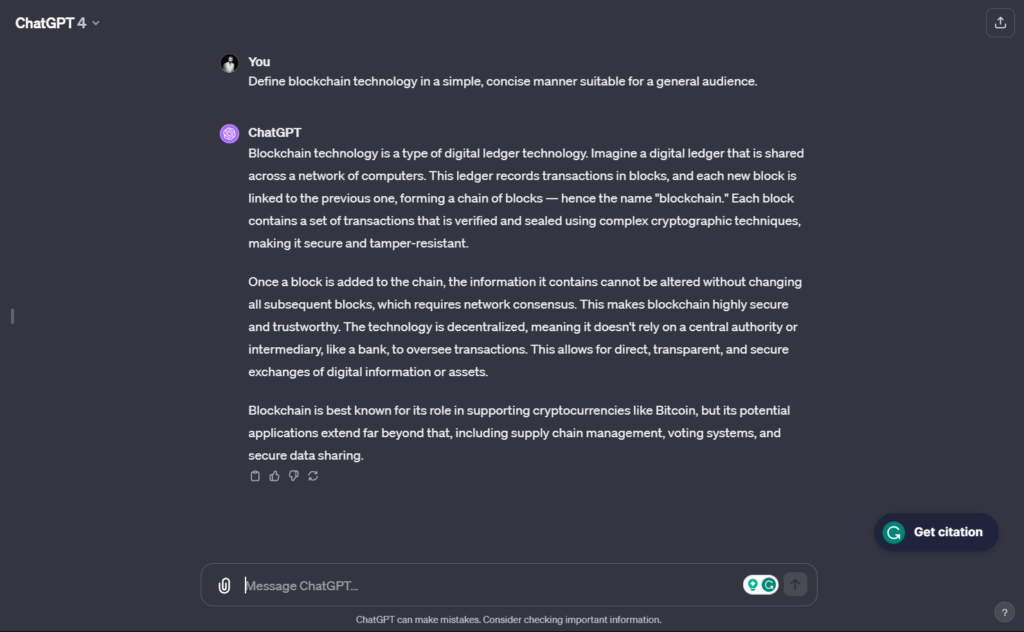
For instance, if you’re writing an article on ‘Blockchain Technology’ and need a concise definition, you might prompt the AI with: “Define blockchain technology in a simple, concise manner suitable for a general audience.” The AI uses its general knowledge to provide a definition without needing specific examples or context.
One-shot Prompt
One-shot prompts provide the AI with a single, clear example, much like giving a chef a specific recipe to follow. This technique helps the AI understand the format and style you expect in its response.
One-shot prompts are great for when you have a specific format or style in mind.
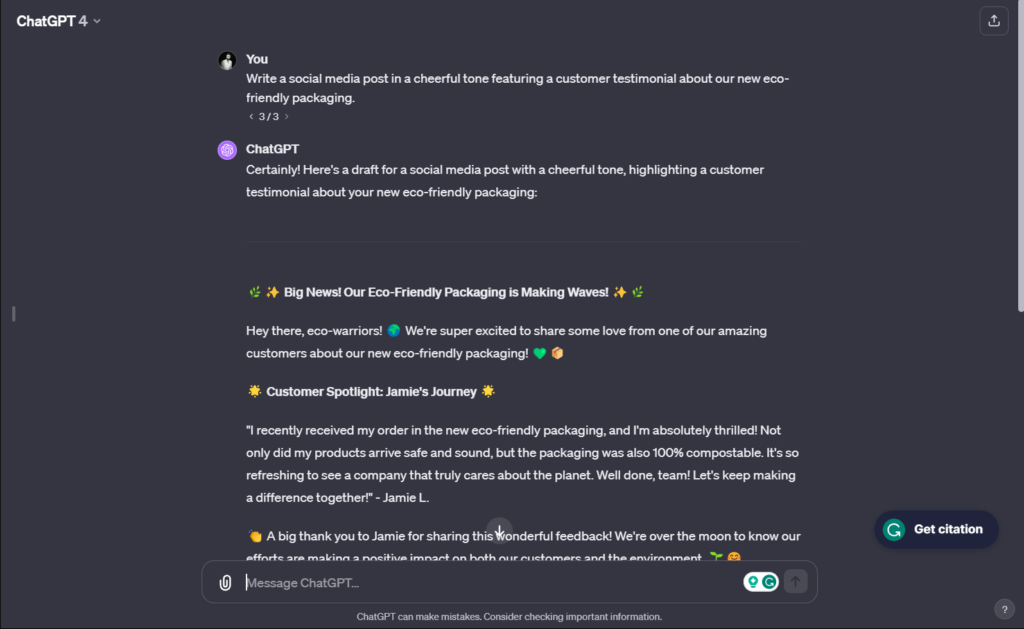
Suppose you’re creating a series of social media posts highlighting customer testimonials. You could provide the AI with a single example: “Write a social media post in a cheerful tone featuring a customer testimonial about our new eco-friendly packaging.” This gives the AI a model to replicate in style and tone for subsequent posts.
Few-shot Prompt
In few-shot prompts, you give the AI multiple examples. It’s like offering a chef several recipes for inspiration. This approach helps the AI better understand the nuances of the task and produce more accurate results.
Few-shot prompts are useful for more nuanced or complex content types. Let’s say you’re writing a series of blog posts on ‘Healthy Eating Habits’. You might provide the AI with multiple introductions from similar articles to help it understand the desired tone, structure, and content.
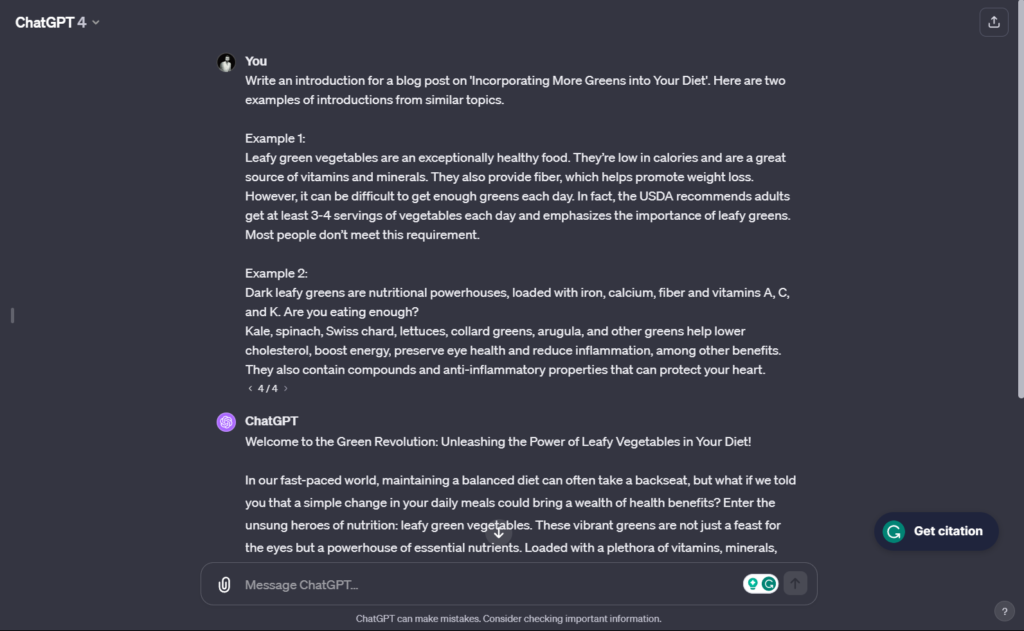
For example: “Write an introduction for a blog post on ‘Incorporating More Greens into Your Diet’. Here are two examples of introductions from similar topics.” This helps the AI to better grasp the style and substance expected in the output.
Chain-of-Thought Prompts
Chain-of-thought prompts are a series of interconnected instructions, guiding the AI through a process. Imagine guiding a chef through a multi-course meal preparation, where each dish influences the next. This technique is ideal for complex tasks, ensuring the AI maintains context throughout the conversation.
Chain-of-thought prompts are ideal for developing ideas or maintaining a narrative over a longer piece of content. For example, if you’re writing an in-depth guide on ‘Starting a Home-Based Business’, you could start with an initial prompt like, “List the key steps to starting a home-based business.”
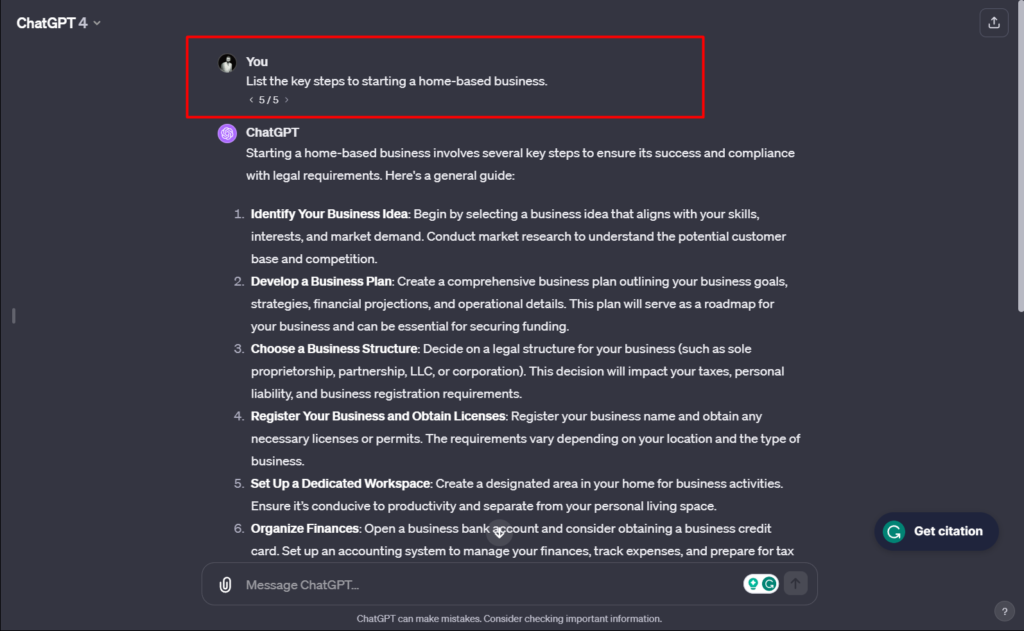
After receiving the list, the next prompt could be, “Elaborate on the first step, explaining the legal considerations in simple terms.” This method allows the AI to build on previous responses, creating a cohesive and comprehensive guide.
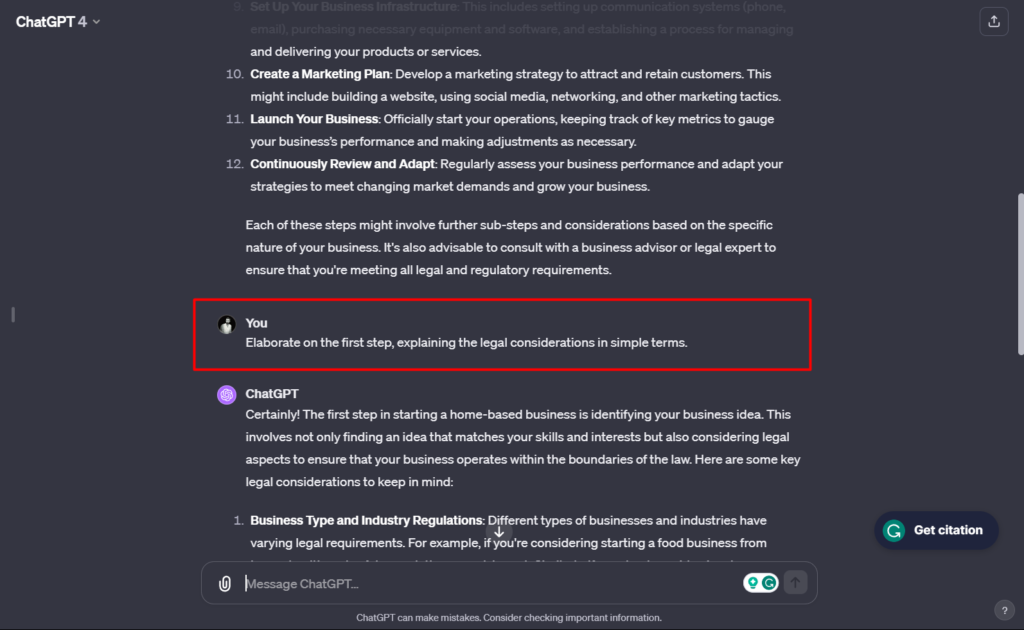
Tips for Effective Prompt Engineering
AI, as a dedicated and advanced component of your marketing processes, is capable of managing almost any monotonous task you assign to it.
However, before integrating AI into your workflow, it’s crucial to understand some key guidelines to ensure a successful collaboration between you and AI.
1. Adopt a “Beginner’s Mindset”
When dealing with AI, think like a beginner. AI, unlike humans, doesn’t grasp nuances and assumptions. It’s like explaining a recipe to someone who’s never cooked before.
Let’s say you’re instructing an AI to write a blog post about ‘The Benefits of Meditation’. Instead of simply saying, “Write a post on meditation benefits,” provide clear, detailed instructions.
For instance: “Write a 500-word beginner-friendly blog post on the benefits of meditation, focusing on mental health, stress reduction, and improved concentration. Include an introductory paragraph, three main sections, and a conclusion. Use simple language suitable for readers with no prior knowledge of meditation.”
This approach ensures that the AI understands your instructions precisely and produces the results you expect.
2. Choose the Right AI Tool for the Job
Selecting the appropriate AI tool is crucial, just as a chef chooses the right utensils and appliances. Consider the AI’s training, capabilities, and how it fits into your workflow.
Suppose you need to create SEO-optimized content. In this case, choose an AI tool specifically designed for SEO content creation. It should understand SEO principles, analyze keywords, and suggest optimizations.
On the other hand, when crafting email marketing content, the ideal AI tool should understand the principles of persuasive writing and be capable of personalizing content for different segments of your audience. It should help create compelling subject lines and body text that resonate with the recipient.
3. Always, Always, Always Fact-check
AI can be a creative powerhouse, but it’s not infallible. Always fact-check the content it generates. This is similar to taste-testing a dish before serving.
Imagine the AI generates a blog post on ‘Latest Digital Marketing Trends’. Before publishing, make sure to verify all facts and figures. For instance, if the AI mentions “a 50% increase in social media marketing ROI in 2023,” check credible sources to confirm this statistic.
Most of the time, AI tools gather information from sources that ranks high on SERPs; irrespective of their credibility. This is why, you should always look for the source of the information and cross-verify it.
This is crucial to maintain credibility and trustworthiness in your content.
4. For Longform Content, Work Prompt-by-Prompt
Tackling long-form content with AI is like cooking a complex meal. Consider breaking it down into smaller, manageable parts. Use AI to flesh out each section, then review and refine.
For example, if you’re creating a comprehensive guide on ‘Starting a Small Business’, break it down into sections like business planning, financing, legal aspects, and marketing.
First, prompt the AI to draft a section on business planning. Review and refine it, then move on to the next section. This step-by-step approach ensures each part is well-crafted and maintains a consistent quality throughout the guide.
Prompt Templates to Help You Get Started
Use the following templates to see your content going next level with AI. Of course, you should improve them based on your output requirement and writing niche.
Blog Post Prompt Template
If you’re an SEO content writer, this prompt will be of a great help to start with:
Title: [Insert Blog Title]
Audience: [Describe the target audience, e.g., beginners in gardening, tech enthusiasts, etc.]
Tone: [Specify the desired tone, e.g., informative, casual, professional]
Key Points:
[List the main point or topic to cover]
[Additional point or subtopic]
[Further point or subtopic]
SEO Keywords: [List relevant SEO keywords to include]
Call to Action: [Describe the desired action you want readers to take after reading the blog]
Prompt to AI: “Create a 1000-word blog post titled ‘[Blog Title]’ targeted at [Audience]. The tone should be [Tone]. Ensure to cover the key points: [List key points]. Include the following SEO keywords: [List SEO keywords]. Conclude with a call to action encouraging the reader to [Call to Action].”
Email Copy Prompt Template
Subject Line: [Insert potential subject lines]
Audience: [Define the audience segment]
Purpose: [State the email’s purpose, e.g., promotion, newsletter update, event invitation]
Key Message: [Outline the main message or offer]
Tone: [Specify the tone, e.g., persuasive, friendly, formal]
Call to Action: [Clearly state what you want the recipient to do next]
Prompt to AI: “Write an email with the subject line ‘[Subject Line]’ for [Audience]. The email’s purpose is [Purpose] and should convey [Key Message]. Maintain a [Tone] tone throughout and conclude with a call to action prompting the reader to [Call to Action].”
Social Media Post Prompt Template
Platform: [Specify the platform, e.g., Facebook, Twitter, Instagram]
Objective: [State the post’s objective, e.g., engagement, sharing information, promoting a product]
Tone: [Define the tone, e.g., lighthearted, serious, motivational]
Hashtags: [List relevant hashtags]
Visual Elements: [Describe any images or videos to be included]
Prompt to AI: “Create a social media post for [Platform] with the objective of [Objective]. The tone should be [Tone]. Include relevant hashtags: [Hashtags]. The post should align with the following visual elements: [Visual Elements].”
Google Ads Copy Prompt Template
Product/Service: [Describe the product/service being advertised]
Target Audience: [Define the target audience]
Unique Selling Points: [List key features or benefits]
Keywords: [List relevant keywords for the ad]
Tone: [Specify the desired tone, e.g., persuasive, informative]
Call to Action: [State the action you want the user to take]
Prompt to AI: “Develop a Google Ads copy for [Product/Service] targeting [Target Audience]. Highlight these unique selling points: [Unique Selling Points]. Incorporate these keywords: [Keywords]. The tone should be [Tone], and it should motivate the viewer to [Call to Action].”
We’re at the Tip of the Iceberg
The potential of AI we’re exploring at this moment is just the tip of the iceberg. We’re yet to explore the depth of the ocean and the coming years will pave the way for it.
As AI advances, it’s a must for content writers to be in tune with it and explore it’s fullest potential so that it never replace them.
Don’t forget, if AI is a horse, we’re the jockey.

I’m a marketer turned into a content writer. I go the unconventional paths of content writing to explore the horizon of possibilities and novel approaches to help brands communicate.
If you’ve loved reading this blog, hit me a ‘Hi’ on LinkedIn.

4 thoughts on “What is Prompt Engineering in Content Writing? 4 Tips for Excellence”